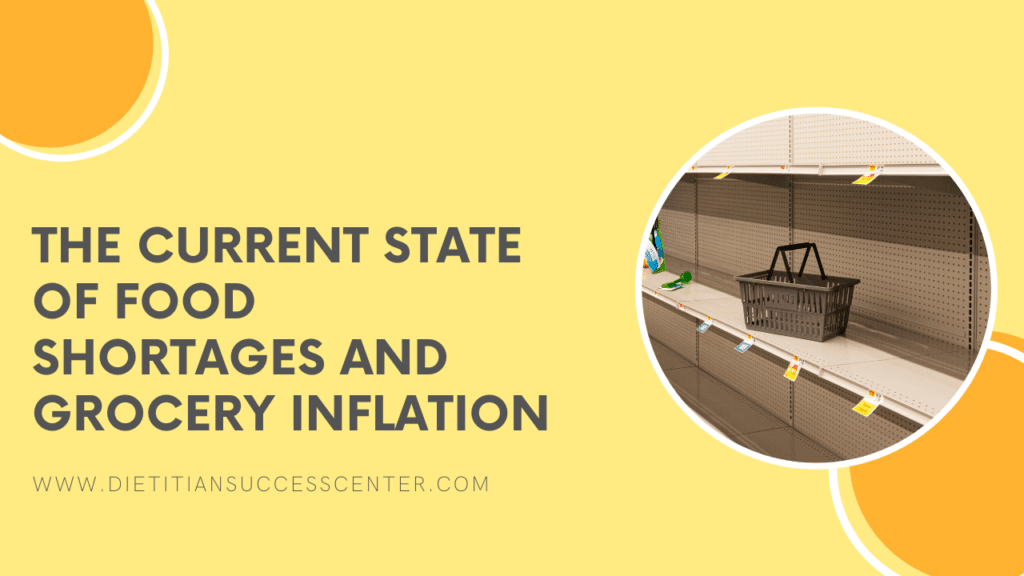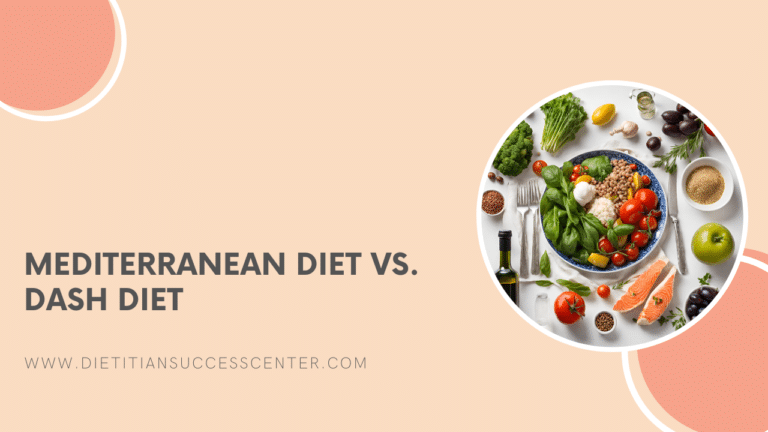

Written by Olivia Farrow, RD, MHSc
Reviewed by Krista Kolodziejzyk, RD, MPH, MBA
As experts in nutrition and food science, dietitians play a vital role in guiding individuals and communities toward health and well-being. In today’s economic landscape, it is crucial for dietitians to be aware of the current state of food shortages and grocery price inflation. These intertwined issues have significant implications for individuals’ access to nutritious food and their ability to maintain a balanced diet.
In this blog post, we will explore what dietitians should know about rising food prices and food shortages and how to apply this knowledge to all professional settings.
The Current State
In the past few years, we have seen unprecedented changes to the foods available to consumers. In some countries, food prices have risen to the highest level in decades (1,2). Food shortages and supply chain issues have contributed to the increased price of food and in some cases, decreased quality and shelf-life (1).
Contributing factors include:
Weather Events / Climate Change: Erratic weather in recent years including extreme heat waves, megadroughts, and floods, have disrupted agricultural production and affected crop yields (1,3,4). This has led to reduced supply and subsequent price increases.
Supply Chain Disruptions: The pandemic exposed vulnerabilities in global supply chains, disrupting the flow of goods and impacting the availability of food products. Transportation delays, labor shortages, and border restrictions have all contributed to the current challenges with the supply of food (1,3,4).
Global Conflict: The devastation from the war in Ukraine has impacted the supply of Russian and Ukrainian export commodities like wheat, sunflower oil, and fish. Farming inputs such as fertilizer and fuel for machinery and transportation have also been impacted, affecting the availability (and affordability) of large-scale crops grown closer to home, like corn, wheat, soy, and rice (1,3,4).
Livestock Illnesses: Cases of viral illness among livestock, such as bird flu, has led to supply deficits and subsequent price increases for meat and animal products like eggs (5).
“Greedflation”: Though there has been no conclusive evidence, large food corporations and grocery retailers in North America have been accused of over-inflating or maintaining inflated prices of food items (1,6). It is speculated that these corporations are profiting from the high cost of food and keeping food prices high knowing that some consumers will accept the high prices on the store shelves (1,6).
The Impact
Food price increases and availability issues will most severely affect those who are vulnerable and experiencing food insecurity (2,4). Individuals and families on the brink of food insecurity may be suddenly forced to rely on charitable food programs (food banks, government support programs, etc.) to afford their living expenses (7).
Dietitians should be aware of the following impacts of rising food prices and food shortages:
-
- Reduced Food Availability: Food shortages and increased prices result in limited access to nutritious food products. This scarcity can lead to a lack of dietary variety and pose challenges for individuals trying to follow balanced eating patterns.
-
- Food Insecurity: Food shortages can exacerbate food insecurity, affecting vulnerable populations disproportionately. Dietitians should be aware of the signs of food insecurity and work collaboratively with individuals and communities to address these issues.
-
- Increased Food Costs: Rising food prices can make it challenging for individuals to afford a nutritious diet. This can lead to compromises in food choices, prioritizing cheaper, less nutritious options over healthier alternatives.
-
- Health Disparities: Grocery price inflation can widen existing health disparities, as individuals with lower incomes may have less access to affordable, healthy foods. Dietitians can address this issue by offering guidance on cost-effective ways to incorporate nutritious ingredients into meals.
Strategies for Dietitians
Dietitians, recognizing the causes and impacts of increased prices and decreased availability of foods, can support clients in aiming for a nutritious diet that meets their dietary needs. However, no amount of meal planning or coupon clipping can prevent or manage poverty (7).
Education and Awareness: Dietitians should stay updated on the current state of food shortages and grocery price inflation to provide accurate information to clients. Sharing resources, tips, and strategies for saving money on food and making the most of available food options can empower individuals to make informed choices.
Meal Planning and Budgeting: Collaborating with clients to develop personalized meal and food shopping plans that align with their nutritional needs and financial constraints is essential. Offering tips for affordable food substitutions, bulk buying, and maximizing nutrient density can help clients optimize their diets within their budgets.
Cooking Skills and Food Waste Reduction: Improving cooking skills and promoting food waste reduction can contribute to more economical and sustainable eating habits. Dietitians can provide guidance on meal prepping, proper storage, and creative use of leftovers to minimize waste and save money.
Advocacy and Community Engagement: Dietitians have a unique opportunity to advocate for policies that address food shortages and grocery price inflation. Collaborating with community organizations, policymakers, and stakeholders can help drive systemic change and improve food access and fair living wages for all.
Key Messages for Dietitians
-
- Dietitians are at the forefront of promoting health and nutrition, and it is crucial to understand the current state of food shortages and grocery price inflation.
-
- By staying informed and providing practical guidance, dietitians can empower individuals to make informed food choices, despite the challenges posed by limited food availability and rising costs.
-
- Through education, advocacy, and community engagement, dietitians can play an active role in addressing these issues and working towards a more equitable and sustainable food system.
References
- Dalhousie University. “Canada’s Food Price Report”. 13th Edition. (2023). Available from: https://www.dal.ca/sites/agri-food/research/canada-s-food-price-report-2023.html
- World Economic Forum. “Food Security: These countries have been the hardest hit by food price inflation” (2023). Available from: https://www.weforum.org/agenda/2023/02/countries-hit-by-food-prices-inflation-cost-of-living-crisis/
- Fradella, A. “Behind the Numbers: What’s Causing Growth in Food Prices” (2022). Statistics Canada. Available from: https://www150.statcan.gc.ca/n1/pub/62f0014m/62f0014m2022014-eng.htm
- World Food Programme. “A Global Food Crisis” (2023). Available from: https://www.wfp.org/global-hunger-crisis
- United States Department of Agriculture. “Summary Findings: Food Price Outlook, 2023” (2023). Available from: https://www.ers.usda.gov/data-products/food-price-outlook/summary-findings/
- Wiener-Bronner, D. “The cost of food is down, but grocery bills are still up. Here’s why” (2023). Available from: https://www.cnn.com/2023/03/08/economy/food-prices-inflation/index.html
- Hetherington, Neil. “Our fixation with food inflation is missing the bigger picture”. (2023). Available from: https://www.tvo.org/article/our-fixation-with-food-inflation-is-missing-the-bigger-picture








